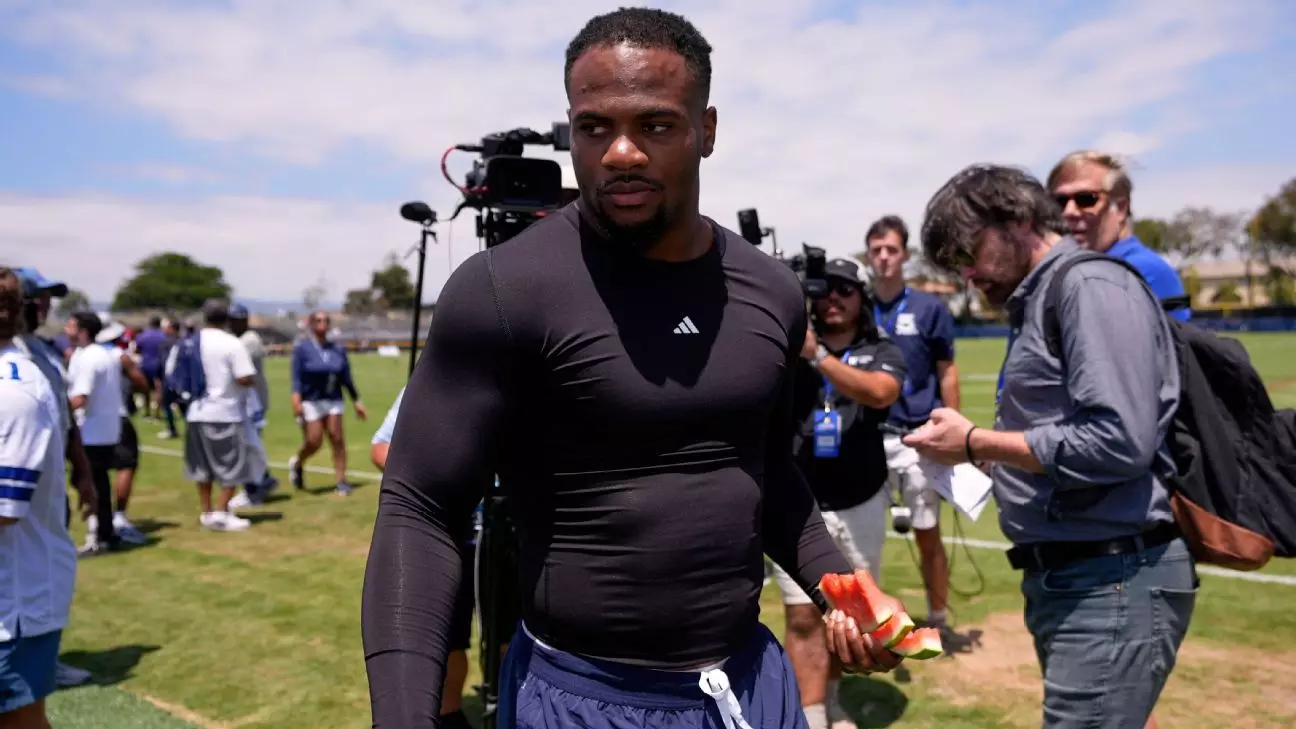In the high-stakes world of professional football, contract negotiations often cast long shadows over team stability and player focus. The Dallas Cowboys find themselves at such a crossroads with Micah Parsons, a young star whose talent is undeniable yet whose future with the team remains uncertain. Despite the absence of a definitive deal, there is an underlying confidence from coaching staff, notably head coach Brian Schottenheimer, that Parsons will be ready to make an impactful return for the season opener against the Philadelphia Eagles. However, this optimism should be scrutinized critically; without a concrete contract extension, the lingering uncertainty may influence Parsons’s motivation, practice intensity, and overall team chemistry.
The fact that negotiations have stalled raises questions about long-term planning. Owner Jerry Jones suggested in March that the framework of a deal was in place, but subsequent discussions have yet to materialize. This disconnect hints at a broader issue: the team’s ability—or possible reluctance—to secure its emerging superstar well before the season kicks off. Such contractual ambiguity can subtly erode the focus needed for peak performance, creating an environment where both player and team must operate amid a cloud of uncertainty. While Schottenheimer exudes confidence, it’s worth considering whether that assurance is based on faith in Parsons’s professionalism or wishful thinking.
Physical Readiness Versus Tactical Preparedness
From a purely physical perspective, Parsons’s situation is complicated. The linebacker has not participated in full-contact practices during training camp due to back tightness, instead engaging in walkthroughs and meetings. This limited participation opens a window for concern: can a player who has not undergone the rigors of live practice match the readiness of his teammates when the season begins? Schottenheimer emphasizes Parsons’s meticulous self-care, reinforcing belief that he will be primed for game day. Yet, the difference between mental preparedness and actual game readiness remains significant.
Here lies a critical challenge—how does one quantify an athlete’s readiness without full-contact reps? The coach’s reliance on Parsons’s body awareness and prior conditioning is understandable, but it overlooks the unpredictable nature of injuries, especially soft tissue ones that can worsen with sudden changes of direction or intense physical strain. The Cowboys’s strategy seems to lean on cautious optimism, banking on their medical and strength staff to mitigate risks. But the key question persists: can Parsons replicate the explosive pass-rushing skills needed for the NFL’s toughest defenses without on-field reps? This is where the reputation of Parsons as a game-changing force becomes both a hope and a gamble.
Implications for the Cowboys’ Strategic Depth and Roster Management
The uncertainty surrounding Parsons’s availability also influences the Cowboys’ roster decisions leading into final cuts. With a tight deadline and only a limited number of practices remaining, the coaching staff faces a delicate balancing act. If Parsons remains somewhat limited or is deemed unready, Dallas might feel compelled to keep an extra pass rusher to ensure defensive potency. Conversely, if Parsons’s health and readiness are assured, the team can focus on trimming their roster with more confidence, streamlining their defensive rotation.
This situation underscores a broader truth: the value of a player like Parsons extends far beyond his individual stats. As a nucleus of Dallas’s defensive front, his presence or absence can ripple across the entire scheme, affecting everything from game planning to in-game adjustments. The team’s reliance on his disruptive ability means they must weigh the risks of rushing him back too soon against the strategic necessity of fielding their best defense. Ultimately, this dynamic illustrates how much hinges on a single player’s health and mindset—an aspect often underestimated until it hits the field.
The Power of Leadership and Future Expectations
Despite the contract stalemate, Parsons’s leadership and innate talent remain unquestioned. His ability to generate pressure and create turnovers is central to the Cowboys’ defensive identity. The coaching staff’s unwavering confidence in his readiness speaks to their belief in his professionalism and resilience. Still, this reliance on faith raises concerns: can a team afford to operate with such a critical piece in a state of contractual limbo? The answer likely depends on Parsons’s behavior in the coming days—if he continues to exhibit the same work ethic and commitment, perhaps the internal assurances will translate into tangible on-field performance.
Looking ahead, this situation is emblematic of a broader narrative in the NFL where emerging stars must navigate the delicate intersection of performance, health, and contractual security. For Dallas, the real victory may lie in fostering an environment where Parsons feels valued and motivated, regardless of the current negotiations. His potential to redefine the team’s defensive capabilities is vast, but that potential can be realized only if the team balances optimism with strategic caution, prioritizing health and readiness above all.
Parsons’s journey toward the season opener encapsulates the complex interplay of talent, health, and business. As Dallas prepares for their first game, all eyes will be on how effectively Parsons can translate his physical and mental preparation into game-day dominance, regardless of the unresolved contract. This scenario underscores a fundamental truth: in football, as in life, the difference between greatness and disappointment often hinges on the unseen behind-the-scenes battles won through perseverance and strategic patience.


Leave a Reply